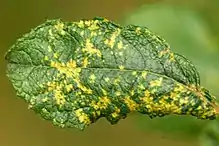Melampsora caprearum
Melampsora caprearum is a fungal pathogen which causes galls on willows (Salix species). Also known as a rust fungus, it was first described by Felix von Thümen in 1879.
| Melampsora caprearum | |
|---|---|
 | |
| Scientific classification | |
| Kingdom: | Fungi |
| Division: | Basidiomycota |
| Class: | Pucciniomycetes |
| Order: | Pucciniales |
| Family: | Melampsoraceae |
| Genus: | Melampsora |
| Species: | M. caprearum |
| Binomial name | |
| Melampsora caprearum Thüm. 1879 | |
| Synonyms | |
|
Melampsora laricis-caprearum Klebahn, 1897 | |
Description
Melampsora caprearum distorts the blades and veins of willow leaves, causing irregular spots with yellow-orange uredinia (which produce a powdery mass of spores). The rust has been found on eared willow (Salix aurita), goat willow (S. caprea), grey willow (S. cinerea) and their hybrids.[1][2]
Distribution
Has been recorded from Belgium (photo), Finland, Great Britain (common) and Poland.[1][2][3]
References
- Redfern, Margaret; Shirley, Peter; Boxham, Michael (2011). British Plant Galls (Second ed.). Shrewsbury: Field Study Council. pp. 282–299. ISBN 978-185153-284-1.
- Ellis, W N. "Melampsora caprearum Thümen 1879". Plant Parasites of Europe. Retrieved 29 December 2017.
- "Category:Melampsora caprearum". Wikimedia Commons. Retrieved 29 December 2017.
This article is issued from Wikipedia. The text is licensed under Creative Commons - Attribution - Sharealike. Additional terms may apply for the media files.